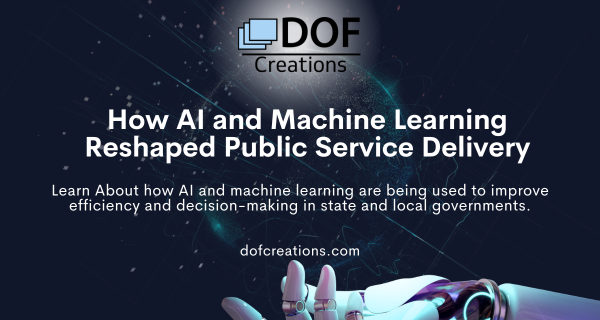How AI and Machine Learning Reshaped Public Service Delivery
In the past decade, artificial intelligence (AI) and machine learning (ML) technologies have quickly grown from nascent concepts to practical tools that are reshaping numerous sectors. An area that has particularly benefited from this technological evolution is public service delivery. IT teams are increasingly leveraging AI and ML to augment efficiency, improve decision-making, and ultimately provide better services to their constituencies. Here are some of the ways this is happening now:
Enhancing Efficiency in Public Services
Efficiency is a crucial metric in public service delivery. Governments are constantly seeking ways to offer quicker, more effective services, and AI and ML have proven to be significant assets in this endeavor.
Automating Administrative Tasks
AI-powered automation is one of the most visible ways these technologies have improved efficiency in the public sector. Many administrative tasks in digital and business operations, such as form processing, record keeping, and data entry, are repetitive and time-consuming. AI technologies like Robotic Process Automation (RPA) can handle these tasks more quickly and accurately than humans, freeing up public service workers to focus on more complex, high-value tasks.
For example, the city of Phoenix, Arizona, has automated the process of entering data from handwritten forms into its databases using AI. This move has reduced data entry errors and expedited service delivery.
Predictive Maintenance
AI and ML can also enhance efficiency by predicting and preventing problems before they occur. A notable application is in public infrastructure maintenance. AI-powered predictive maintenance systems analyze various data sources to predict equipment failures and schedule maintenance proactively. These systems minimize downtime and reduce costs associated with sudden equipment failures and emergency repairs.
Improving Decision-Making with AI and ML
Beyond efficiency, AI and ML technologies also play a pivotal role in enhancing decision-making in public service delivery in several ways including:
Data-Driven Policy Making
Governments have access to a vast amount of data, and ML algorithms can analyze this data to uncover patterns and trends that might be invisible to human analysts. This information can guide policy decisions and resource allocations. For instance, the city of Los Angeles uses machine learning to analyze data on homelessness and informs policies designed to address this issue.
AI in Public Health
In the realm of public health, AI has been instrumental in improving decision-making, particularly visible in the COVID-19 pandemic. Governments have used AI models to predict the spread of the virus, inform public health measures, and allocate medical resources efficiently.
Improving Citizen Engagement
Finally, AI and ML technologies have the potential to reshape how governments engage with citizens in different ways such as:
AI-Powered Chatbots
Many state and local governments are using AI-powered chatbots to handle inquiries from the public. These chatbots can provide instant responses to common questions, improving service speed and freeing up human workers to handle more complex inquiries. For example, the state of Utah’s AI chatbot, named “Porter,” has answered over a million questions from citizens since its launch in 2020.
Personalized Services
Governments are also using ML algorithms to provide more personalized services. By analyzing individuals’ interactions with government websites, ML can predict what services a citizen might need and provide tailored recommendations, improving the overall user experience.
The Future of AI and ML in Public Service Delivery
The applications of AI and ML in public service delivery are vast and varied, and we are just beginning to scratch the surface of their potential. As these technologies continue to evolve, they will enable more efficient, data-driven, and personalized public services.
However, this evolution does not come without challenges. Governments must address issues around data privacy and security, algorithmic bias, and the digital divide to ensure these technologies benefit all citizens. Nevertheless, the potential rewards of AI and ML integration into public service delivery are immense, promising a future of public services that are not only more efficient but also more equitable and responsive to the needs of the public.
Smart Cities and IoT
The concept of ‘smart cities’ is becoming more of a reality with the help of AI and ML. By integrating AI with the Internet of Things (IoT), cities can manage resources and services more efficiently. Traffic management, for instance, is being revolutionized by AI-based systems that analyze real-time data from a network of sensors, optimizing traffic flow and reducing congestion.
Augmented Reality (AR) and Virtual Reality (VR)
Moreover, augmented reality (AR) and virtual reality (VR) are expected to play a bigger role in public service delivery in the near future. From virtual tours of public facilities to AR-assisted maintenance and repairs, the integration of AI with AR and VR opens up a plethora of possibilities for efficient and innovative public services.
Climate Change Mitigation
AI and ML also hold significant potential for climate change mitigation, a major concern for state and local governments. They can help in modeling climate change scenarios, optimizing energy consumption, managing waste, and tracking the progress of environmental policies.
DOF’s Final Thoughts
The integration of AI and ML in public service delivery is not a futuristic dream; it is a current reality that is transforming how governments operate. However, to fully reap the benefits of these technologies, governments must be proactive in addressing potential challenges, investing in the necessary infrastructure, and fostering digital literacy among the public.
The potential of AI and ML in public services is only as good as the policies, practices, and people that shape their use. Therefore, it’s not just about implementing new technologies, but also about cultivating a culture of innovation, transparency, and inclusivity in public services. By doing so, state and local governments can ensure that AI and ML technologies contribute to a future of public service that is more responsive, efficient, and equitable. If you want to learn more about how AI and ML can impact, benefit, or change the way your organization operates contact DOF today to schedule a consultation and evaluation.



